- ubuntu12.04环境下使用kvm ioctl接口实现最简单的虚拟机
- Ubuntu 通过无线网络安装Ubuntu Server启动系统后连接无线网络的方法
- 在Ubuntu上搭建网桥的方法
- ubuntu 虚拟机上网方式及相关配置详解
CFSDN坚持开源创造价值,我们致力于搭建一个资源共享平台,让每一个IT人在这里找到属于你的精彩世界.
这篇CFSDN的博客文章python自动化测试三部曲之request+django实现接口测试由作者收集整理,如果你对这篇文章有兴趣,记得点赞哟.
国庆期间准备写三篇博客,介绍和总结下接口测试,由于国庆期间带娃,没有按照计划完成,今天才完成第二篇,惭愧惭愧.
这里我第一篇博客的地址:http://www.zzvips.com/article/108794.html,主要是介绍unittest框架,有兴趣的同学们可以移步去查阅 。
这里废话少说,进入正题 。
我的思路是这样的 。
1、先用django实现登陆、增加、删除、查看4个接口 。
2、在excel定义好测试案例、然后读取excel中的案例,然后把案例用unittest框架组装和封装 。
3、启动django,执行测试案例 。
1、先跑通unittest到django的流程 。
1、先创建一个Django的项目 。
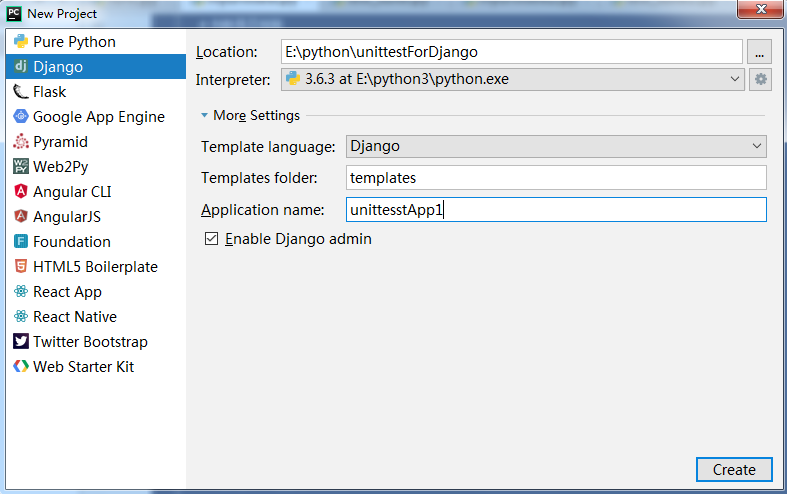
2、创建路由,这里我们使用二级路由 。
a、先复制工程目录下的urls.py文件到app目录下 。
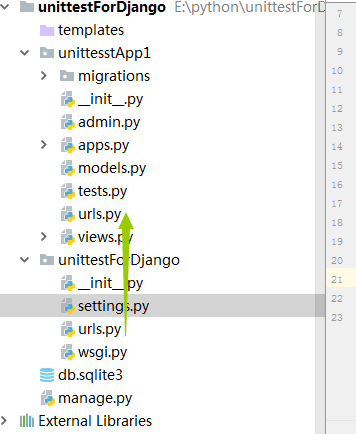
b、修改工程目录下的urls.py文件,定义一级路由 。
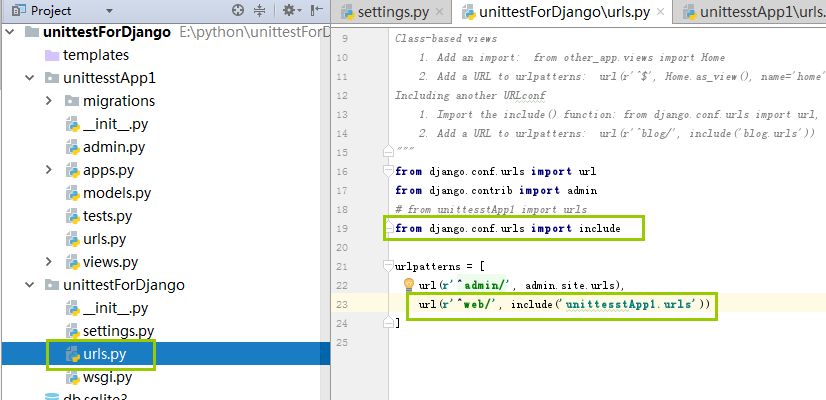
c、修改app目录下的urls.py文件,设置二级路由,这里切记务必要删除默认的admin这条路由 。
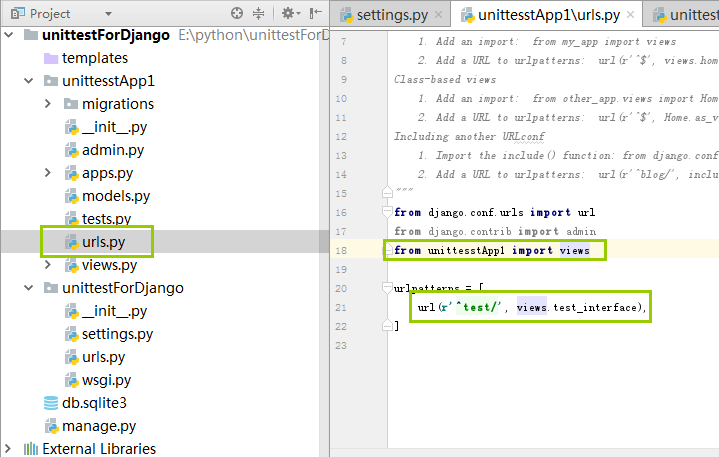
d、定义这条路由指向的视图的函数 。
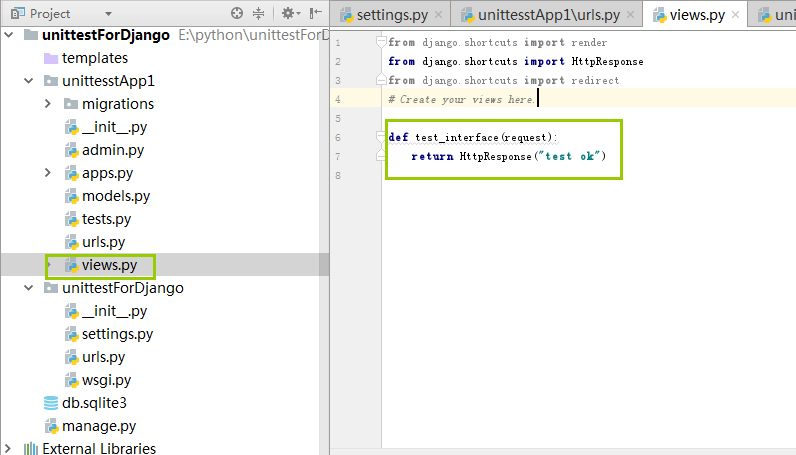
e、启动django,这里我们使用9090端口启动,因为我们的Jenkins端口用的是8080 。
E:\python\unittestForDjango>python manage.py runserver 9090 。
f、这里的是启动成功的样式,我圈住的告警可以忽略,因为这里Django的admin需要的,我们这里不会用到django的admin 。

g、打开浏览器访问django,我们的一个简单的Django项目已经跑通 。

3、在视图函数中定义一个方法,这个方法分别处理GET请求和POST请求 。
a、定义视图函数 。
这里通过这个参数告诉浏览器,我们返回的是JSON数据 。
return HttpResponse(result, content_type="application/json;charset=utf-8")
def test_login(request): method = request.method.upper() if method == "GET": result = {} name = request.GET.get("username",None) pwd = request.GET.get("pwd",None) result["name"] = name result["pwd"] = pwd result = json.dumps(result) # return HttpResponse(result) return HttpResponse(result, content_type="application/json;charset=utf-8") else: result = {} name = request.POST.get("username",None) pwd = request.POST.get("pwd",None) result["name"] = name result["pwd"] = pwd result = json.dumps(result) return HttpResponse(result,content_type="application/json;charset=utf-8")
b、使用request模块发起POST和GET请求 。
#Auther Bob#--*--conding:utf-8 --*--import requestsimport jsonclass TestCase(object): def __init__(self,username,pwd,url): self.username = username self.pwd = pwd self.url = url def get(self): # 发送get请求 url = self.url + "?username=" + str(self.username) + "&" + "pwd=" + str(self.pwd) res = requests.get(url=url) print(res.text,type(res.text)) def post(self): # 发送post请求 data = { "username" : self.username, "pwd" : self.pwd } res = requests.post(url=self.url,data=data) print(res.text)if __name__ == '__main__': url = "http://127.0.0.1:9090/web/login/" username = "zhangsan" pwd = "123" t = TestCase(username,pwd,url) t.get() t.post()
c、这里我们引入unittest框架,测试案例可以这么写 。
import unittestfrom test3 import test_requestclass TestDjango(unittest.TestCase): def setUp(self): print("unittest框架的前置条件") def tearDown(self): print("unittest框架的后置条件") def test_01(self): url = "http://127.0.0.1:9090/web/login/" username = "zhangsan" pwd = "123" t = test_request.TestCase(url=url,username=username,pwd=pwd) def test_02(self): url = "http://127.0.0.1:9090/web/login/" username = "zhangsan" pwd = "123" t = test_request.TestCase(url=url,username=username,pwd=pwd) t.post()if __name__ == '__main__': unittest.main(verbosity=2)
d、这里有重复代码,我们可以利用unittest框架中的classmethod来解决,因为实例化一个测试类可以放在前置条件中 。
import unittestfrom test3 import test_requestclass TestDjango(unittest.TestCase): @classmethod def setUpClass(cls): url = "http://127.0.0.1:9090/web/login/" username = "zhangsan" pwd = "123" # 这里的t虽然是类变量,但是python的中的实例是可以用引用类变量的 cls.t = test_request.TestCase(url=url,username=username,pwd=pwd) def setUp(self): print("unittest框架的前置条件") def tearDown(self): print("unittest框架的后置条件") def test_01(self): self.t.get() def test_02(self): self.t.post()if __name__ == '__main__': unittest.main(verbosity=2)
e、在testcase中加入断言 。
import unittestfrom test3 import test_requestclass TestDjango(unittest.TestCase): @classmethod def setUpClass(cls): url = "http://127.0.0.1:9090/web/login/" username = "zhangsan" pwd = "123" # 这里的t虽然是类变量,但是python的中的实例是可以用引用类变量的 cls.t = test_request.TestCase(url=url,username=username,pwd=pwd) def setUp(self): print("unittest框架的前置条件") def tearDown(self): print("unittest框架的后置条件") def test_01(self): res = self.t.get() self.assertEqual(200,res.status_code) def test_02(self): res = self.t.post() self.assertEqual(200, res.status_code)if __name__ == '__main__': unittest.main(verbosity=2)
f、引入testsuite 。
import unittestfrom unittest import TestLoaderfrom test3 import test_unittestif __name__ == '__main__': suite = unittest.TestSuite() loader = TestLoader() test_cases1 = unittest.TestLoader().loadTestsFromModule(test_unittest) # 参数是一个模块,会把这个模块里的所有case加载进来 suite.addTests(test_cases1) runner = unittest.TextTestRunner(verbosity=2) runner.run(suite)
2、在django中设计接口 。
这里我们写一个简单的例子,设计一个用户表,设计4个接口 。
接口1:登陆 。
接口2:增加用户,需要用户登陆 。
接口3:删除用户,需要用户登陆 。
接口4:查询用户,不需要用户登陆 。
1、先看登陆接口 。
a、登录接口对应的url 。
下面是一级路由 。
url(r'^web/', include('unittesstApp1.urls'))
下面是二级路由 。
url(r'^login/', views.test_login),
b、登录接口的视图函数 。
def test_login(request): method = request.method.upper() if method == "GET": returndict = {"code": 200, "error": None} username = request.GET.get("username",None) password = request.GET.get("password",None) if username == "admin" and password == "admin123.": request.session["username"] = username request.session["password"] = password result = json.dumps(returndict) else: returndict["code"] = 201 returndict["error"] = "用户名或者密码错误" result = json.dumps(returndict) return HttpResponse(result,content_type="application/json;charset=utf-8")
这里我们用到了session来代替cookies 。
。
2、增加用户接口 。
a、增加用户对应的url 。
一级路由同登陆接口,下面是二级路由 。
url(r'^add/', views.test_add),
b、增加用户接口对应的视图函数,这里我们做了各种异常处理,且判断了用户是否登陆,也就是通过是否携带cookies来判断 。
def test_add(request): method = request.method.upper() if method == "POST": returndict = {"code": 200, "error": None} username = request.session.get("username",None) password = request.session.get("password",None) if username == "admin" and password == "admin123.": newusername = request.POST.get("username",None) age = request.POST.get("age",None) sex = request.POST.get("sex",None) pwd = request.POST.get("pwd",None) userinfo = [newusername,age,sex,pwd] print(userinfo) if not "None" in userinfo and all(userinfo): if models.userInfo.objects.filter(username = userinfo[0]).exists(): returndict["error"] = "{username} is exists,please add a new username".format(username = username) returndict["code"] = 201 result = json.dumps(returndict) return HttpResponse(result, content_type="application/json;charset=utf-8") else: models.userInfo.objects.create( username = newusername, age = age, sex = sex, pwd = pwd ) if models.userInfo.objects.filter(username=userinfo[0]).exists(): result = json.dumps(returndict) return HttpResponse(result, content_type="application/json;charset=utf-8") else: returndict["error"] = "{username} is error,please retry add".format(username=username) returndict["code"] = 201 result = json.dumps(returndict) return HttpResponse(result, content_type="application/json;charset=utf-8") else: returndict["error"] = "must input username,age,sex,pwd" returndict["code"] = 201 result = json.dumps(returndict) return HttpResponse(result, content_type="application/json;charset=utf-8") else: returndict = {"code": 201, "error": "用户名或者密码错误"} result = json.dumps(returndict) return HttpResponse(result, content_type="application/json;charset=utf-8")
3、删除接口 。
a、删除用户对应的url 。
一级路由同登陆接口,这里只看二级路由 。
url(r'^del/', views.del_user),
b、删除接口对应的视图函数,这里我做了各种异常处理,也做了用户是否登陆的检测,也是通过检测cookies来实现 。
def del_user(request): method = request.method.upper() if method == "POST": returndict = {"code": 200, "error": None} username = request.session.get("username",None) password = request.session.get("password",None) if username == "admin" and password == "admin123.": delusername = request.POST.get("username",None) print(delusername) if delusername != None: if models.userInfo.objects.filter(username=delusername).exists(): delid = models.userInfo.objects.get(username=delusername).id print(delid) try: models.userInfo.objects.get(id=delid).delete() except Exception as e: returndict = {"code": 201, "error": e} result = json.dumps(returndict) return HttpResponse(result, content_type="application/json;charset=utf-8") else: result = json.dumps(returndict) return HttpResponse(result, content_type="application/json;charset=utf-8") else: returndict = {"code": 201, "error": "{username} is not exists".format(username = delusername)} result = json.dumps(returndict) return HttpResponse(result, content_type="application/json;charset=utf-8") else: returndict = {"code": 201, "error": "you must input a username"} result = json.dumps(returndict) return HttpResponse(result, content_type="application/json;charset=utf-8") else: returndict = {"code": 201, "error": "username or password is error"} result = json.dumps(returndict) return HttpResponse(result, content_type="application/json;charset=utf-8")
4、查看接口 。
a、查看接口对应的url 。
一级路由同登陆接口url,下面是二级路由 。
url(r'^scan/', views.get_user),
b、查看接口对应的url,这里我们不检测用户是否登陆,直接把查到的数据返回给客户,如果查询报错,才返回错误的信息 。
def get_user(request): method = request.method.upper() returndict = {"code": 200, "userinfo": None} if method == "GET": try: alluser = models.userInfo.objects.all().values_list("username") alluserlist = [] for i in alluser: alluserlist.append(i) returndict["userinfo"] = alluserlist except Exception as e: returndict["code"] = "201" returndict["error"] = e finally: result = json.dumps(returndict) return HttpResponse(result, content_type="application/json;charset=utf-8")
5、设计删除数据库中所有的接口,用来做后置条件 。
def del_alluser(request): method = request.method.upper() if method == "POST": returndict = {"code": 200, "error": None} username = request.session.get("username", None) password = request.session.get("password", None) if username == "admin" and password == "admin123.": if models.userInfo.objects.all().count() > 0: models.userInfo.objects.all().delete() result = json.dumps(returndict) return HttpResponse(result, content_type="application/json;charset=utf-8")
3、案例准备 。
1、在excel中写好接口测试案例 。

2、定义常量,也就是每列对应的值 。
class TestConfig(object): def __init__(self): self.name = 0 self.url = 1 self.method = 2 self.cookies = 3 self.data = 4 self.res = 5 self.exec = 6 def getname(self): return self.name def geturl(self): return self.url def getmethod(self): return self.method def getcookies(self): return self.cookies def getdata(self): return self.data def getres(self): return self.res def getexec(self): return self.exec
3、定义读取excel的类,因为我要从excel中读取案例 。
import xlrdimport osclass testexcel(object): casepath = os.path.join(os.path.dirname(os.path.dirname(os.path.abspath(__file__))), "case", "testcase.xlsx") def __init__(self): self.casepath = testexcel.casepath self.execlobj = xlrd.open_workbook(self.casepath) self.sheetobj = self.execlobj.sheet_by_index(0) def get_excel_data(self,row,col): max_row = self.get_excel_max_row() max_col = self.get_excel_max_col() if row > max_row -1 or col > max_col - 1: return False else: data = self.sheetobj.cell_value(row,col) return data def get_excel_max_row(self): r_num = self.sheetobj.nrows return r_num def get_excel_max_col(self): c_num = self.sheetobj.ncols return c_num
4、定义我们的接口函数 。
import requestsimport jsonclass TestLogin(object): def __init__(self,username,pwd,url): self.username = username self.pwd = pwd self.url = url def get(self): # 发送get请求 url = self.url + "?username=" + str(self.username) + "&" + "password=" + str(self.pwd) res = requests.get(url=url, headers={ "user-agent": "Mozilla/5.0 (Windows NT 6.1) AppleWebKit/537.36 (KHTML, like Gecko) Chrome/57.0.2987.133 Safari/537.36" }) # print(json.loads(res.text)) return res def post(self): # 发送post请求 data = { "username" : self.username, "pwd" : self.pwd } res = requests.post(url=self.url, data=data, headers={ "user-agent": "Mozilla/5.0 (Windows NT 6.1) AppleWebKit/537.36 (KHTML, like Gecko) Chrome/57.0.2987.133 Safari/537.36" }, ) # print(res.text) return resclass TestAdd(object): def __init__(self,username,age,sex,pwd,cookies,url): self.username = username self.age = age self.sex = sex self.pwd = pwd self.url = url self.cookies = cookies def post(self): # 发送post请求 data = { "username" : self.username, "pwd" : self.pwd, "age" : self.age, "sex" : self.sex } res = requests.post(url=self.url, data=data, headers={ "user-agent": "Mozilla/5.0 (Windows NT 6.1) AppleWebKit/537.36 (KHTML, like Gecko) Chrome/57.0.2987.133 Safari/537.36" }, cookies=self.cookies, ) # print(res.text) return resclass Testdel(object): def __init__(self, username,cookies,url): self.username = username self.cookies = cookies self.url = url def post(self): # 发送post请求 data = { "username": self.username, } res = requests.post(url=self.url, data=data, headers={ "user-agent": "Mozilla/5.0 (Windows NT 6.1) AppleWebKit/537.36 (KHTML, like Gecko) Chrome/57.0.2987.133 Safari/537.36" }, cookies=self.cookies, ) # print(res.text) return resclass Testscan(object): def __init__(self,url): self.url = url def get(self): res = requests.get(url=self.url, headers={ "user-agent": "Mozilla/5.0 (Windows NT 6.1) AppleWebKit/537.36 (KHTML, like Gecko) Chrome/57.0.2987.133 Safari/537.36" }, cookies=None, ) return res
5、定义测试案例 。
import unittestfrom test3 import test_requestimport jsonfrom util import test_jsonfrom util import test_excelfrom case import testconfigimport requestsclass TestDjango(unittest.TestCase): @classmethod def setUpClass(cls): cls.alldata = test_json.testjson() @classmethod def tearDownClass(cls): url = "http://127.0.0.1:9090/web/login/" + "?username=" + "admin" + "&" + "password=" + "admin123." res = requests.get(url=url, headers={ "user-agent": "Mozilla/5.0 (Windows NT 6.1) AppleWebKit/537.36 (KHTML, like Gecko) Chrome/57.0.2987.133 Safari/537.36" }) url = "http://127.0.0.1:9090/web/delall/" requests.post(url=url, headers={ "user-agent": "Mozilla/5.0 (Windows NT 6.1) AppleWebKit/537.36 (KHTML, like Gecko) Chrome/57.0.2987.133 Safari/537.36" }, cookies = res.cookies ) def get_cookies(self): url = "http://127.0.0.1:9090/web/login/" + "?username=" + "admin" + "&" + "password=" + "admin123." res = requests.get(url=url, headers={ "user-agent": "Mozilla/5.0 (Windows NT 6.1) AppleWebKit/537.36 (KHTML, like Gecko) Chrome/57.0.2987.133 Safari/537.36" }) # print(json.loads(res.text)) return res.cookies @unittest.skip('noexec') def test_login_ok(self): row = 1 configobj = testconfig.TestConfig() excelobj = test_excel.testexcel() execstatus = excelobj.get_excel_data(row,configobj.getexec()) if execstatus == "YES": cookiesstatus = excelobj.get_excel_data(row, configobj.getcookies()) if cookiesstatus == "YES": cookies = self.get_cookies() else: cookies = None data = excelobj.get_excel_data(row, configobj.getdata()) data = json.loads(data) url = excelobj.get_excel_data(row, configobj.geturl()) res = excelobj.get_excel_data(row, configobj.getres()) method = excelobj.get_excel_data(row, configobj.getmethod()) if method == "GET": testobj = test_request.TestLogin(data["username"],data["pwd"],url) resobj = testobj.get() self.assertEqual(int(res),json.loads(resobj.text)["code"]) @unittest.skip('noexec') def test_login_pwd_error(self): row = 2 configobj = testconfig.TestConfig() excelobj = test_excel.testexcel() execstatus = excelobj.get_excel_data(row,configobj.getexec()) if execstatus == "YES": cookiesstatus = excelobj.get_excel_data(row, configobj.getcookies()) if cookiesstatus == "YES": cookies = self.get_cookies() else: cookies = None data = excelobj.get_excel_data(row, configobj.getdata()) data = json.loads(data) url = excelobj.get_excel_data(row, configobj.geturl()) res = excelobj.get_excel_data(row, configobj.getres()) method = excelobj.get_excel_data(row, configobj.getmethod()) if method == "GET": testobj = test_request.TestLogin(data["username"],data["pwd"],url) resobj = testobj.get() self.assertEqual(int(res),json.loads(resobj.text)["code"]) @unittest.skip('noexec') def test_login_user_error(self): row = 3 configobj = testconfig.TestConfig() excelobj = test_excel.testexcel() execstatus = excelobj.get_excel_data(row,configobj.getexec()) if execstatus == "YES": cookiesstatus = excelobj.get_excel_data(row, configobj.getcookies()) if cookiesstatus == "YES": cookies = self.get_cookies() else: cookies = None data = excelobj.get_excel_data(row, configobj.getdata()) data = json.loads(data) url = excelobj.get_excel_data(row, configobj.geturl()) res = excelobj.get_excel_data(row, configobj.getres()) method = excelobj.get_excel_data(row, configobj.getmethod()) if method == "GET": testobj = test_request.TestLogin(data["username"],data["pwd"],url) resobj = testobj.get() self.assertEqual(int(res),json.loads(resobj.text)["code"]) @unittest.skip('noexec') def test_user_pwd_error(self): row = 4 configobj = testconfig.TestConfig() excelobj = test_excel.testexcel() execstatus = excelobj.get_excel_data(row,configobj.getexec()) if execstatus == "YES": cookiesstatus = excelobj.get_excel_data(row, configobj.getcookies()) if cookiesstatus == "YES": cookies = self.get_cookies() else: cookies = None data = excelobj.get_excel_data(row, configobj.getdata()) data = json.loads(data) url = excelobj.get_excel_data(row, configobj.geturl()) res = excelobj.get_excel_data(row, configobj.getres()) method = excelobj.get_excel_data(row, configobj.getmethod()) if method == "GET": testobj = test_request.TestLogin(data["username"],data["pwd"],url) resobj = testobj.get() self.assertEqual(int(res),json.loads(resobj.text)["code"]) @unittest.skip('noexec') def test_insert_ok(self): row = 5 configobj = testconfig.TestConfig() excelobj = test_excel.testexcel() execstatus = excelobj.get_excel_data(row, configobj.getexec()) if execstatus == "YES": cookiesstatus = excelobj.get_excel_data(row, configobj.getcookies()) if cookiesstatus == "YES": cookies = self.get_cookies() else: cookies = None data = excelobj.get_excel_data(row, configobj.getdata()) data = json.loads(data) url = excelobj.get_excel_data(row, configobj.geturl()) res = excelobj.get_excel_data(row, configobj.getres()) method = excelobj.get_excel_data(row, configobj.getmethod()) if method == "POST": testobj = test_request.TestAdd(data["username"], data["age"],data["sex"], data["pwd"],cookies,url) resobj = testobj.post() print(json.loads(resobj.text)) self.assertEqual(int(res), json.loads(resobj.text)["code"]) @unittest.skip('noexec') def test_insert_nologin(self): row = 6 configobj = testconfig.TestConfig() excelobj = test_excel.testexcel() execstatus = excelobj.get_excel_data(row, configobj.getexec()) if execstatus == "YES": cookiesstatus = excelobj.get_excel_data(row, configobj.getcookies()) if cookiesstatus == "YES": cookies = self.get_cookies() else: cookies = None data = excelobj.get_excel_data(row, configobj.getdata()) data = json.loads(data) url = excelobj.get_excel_data(row, configobj.geturl()) res = excelobj.get_excel_data(row, configobj.getres()) method = excelobj.get_excel_data(row, configobj.getmethod()) if method == "POST": testobj = test_request.TestAdd(data["username"], data["age"],data["sex"], data["pwd"],cookies,url) resobj = testobj.post() print(json.loads(resobj.text)) self.assertEqual(int(res), json.loads(resobj.text)["code"]) @unittest.skip("noexec") def test_insert_user_error(self): row = 7 configobj = testconfig.TestConfig() excelobj = test_excel.testexcel() execstatus = excelobj.get_excel_data(row, configobj.getexec()) if execstatus == "YES": cookiesstatus = excelobj.get_excel_data(row, configobj.getcookies()) if cookiesstatus == "YES": cookies = self.get_cookies() else: cookies = None data = excelobj.get_excel_data(row, configobj.getdata()) data = json.loads(data) url = excelobj.get_excel_data(row, configobj.geturl()) res = excelobj.get_excel_data(row, configobj.getres()) method = excelobj.get_excel_data(row, configobj.getmethod()) if method == "POST": testobj = test_request.TestAdd(data.get("username",None), data.get("age",None), data.get("sex",None), data.get("pwd",None), cookies, url) resobj = testobj.post() print(json.loads(resobj.text)) self.assertEqual(int(res), json.loads(resobj.text)["code"]) @unittest.skip('no exec') def test_insert_pwd_error(self): row = 8 configobj = testconfig.TestConfig() excelobj = test_excel.testexcel() execstatus = excelobj.get_excel_data(row, configobj.getexec()) if execstatus == "YES": cookiesstatus = excelobj.get_excel_data(row, configobj.getcookies()) if cookiesstatus == "YES": cookies = self.get_cookies() else: cookies = None data = excelobj.get_excel_data(row, configobj.getdata()) data = json.loads(data) url = excelobj.get_excel_data(row, configobj.geturl()) res = excelobj.get_excel_data(row, configobj.getres()) method = excelobj.get_excel_data(row, configobj.getmethod()) if method == "POST": testobj = test_request.TestAdd(data.get("username",None), data.get("age",None), data.get("sex",None), data.get("pwd",None), cookies, url) resobj = testobj.post() print(json.loads(resobj.text)) self.assertEqual(int(res), json.loads(resobj.text)["code"]) @unittest.skip("no exec") def test_insert_sex_error(self): row = 9 configobj = testconfig.TestConfig() excelobj = test_excel.testexcel() execstatus = excelobj.get_excel_data(row, configobj.getexec()) if execstatus == "YES": cookiesstatus = excelobj.get_excel_data(row, configobj.getcookies()) if cookiesstatus == "YES": cookies = self.get_cookies() else: cookies = None data = excelobj.get_excel_data(row, configobj.getdata()) print(data) data = json.loads(data) print(data) url = excelobj.get_excel_data(row, configobj.geturl()) res = excelobj.get_excel_data(row, configobj.getres()) method = excelobj.get_excel_data(row, configobj.getmethod()) if method == "POST": testobj = test_request.TestAdd(data.get("username",None), data.get("age",None), data.get("sex",None), data.get("pwd",None), cookies, url) resobj = testobj.post() print(json.loads(resobj.text)) self.assertEqual(int(res), json.loads(resobj.text)["code"]) @unittest.skip('no exec') def test_insert_age_error(self): row = 10 configobj = testconfig.TestConfig() excelobj = test_excel.testexcel() execstatus = excelobj.get_excel_data(row, configobj.getexec()) if execstatus == "YES": cookiesstatus = excelobj.get_excel_data(row, configobj.getcookies()) if cookiesstatus == "YES": cookies = self.get_cookies() else: cookies = None data = excelobj.get_excel_data(row, configobj.getdata()) print(data) data = json.loads(data) print(data) url = excelobj.get_excel_data(row, configobj.geturl()) res = excelobj.get_excel_data(row, configobj.getres()) method = excelobj.get_excel_data(row, configobj.getmethod()) if method == "POST": testobj = test_request.TestAdd(data.get("username",None), data.get("age",None), data.get("sex",None), data.get("pwd",None), cookies, url) resobj = testobj.post() print(resobj.text) print(json.loads(resobj.text)) self.assertEqual(int(res), json.loads(resobj.text)["code"]) @unittest.skip('no exec') def test_insert_user_exist(self): row = 11 configobj = testconfig.TestConfig() excelobj = test_excel.testexcel() execstatus = excelobj.get_excel_data(row, configobj.getexec()) if execstatus == "YES": cookiesstatus = excelobj.get_excel_data(row, configobj.getcookies()) if cookiesstatus == "YES": cookies = self.get_cookies() else: cookies = None data = excelobj.get_excel_data(row, configobj.getdata()) print(data) data = json.loads(data) print(data) url = excelobj.get_excel_data(row, configobj.geturl()) res = excelobj.get_excel_data(row, configobj.getres()) method = excelobj.get_excel_data(row, configobj.getmethod()) if method == "POST": testobj = test_request.TestAdd(data.get("username", None), data.get("age", None), data.get("sex", None), data.get("pwd", None), cookies, url) resobj = testobj.post() print(resobj.text) print(json.loads(resobj.text)) self.assertEqual(int(res), json.loads(resobj.text)["code"]) def test_get_user(self): row = 12 configobj = testconfig.TestConfig() excelobj = test_excel.testexcel() execstatus = excelobj.get_excel_data(row, configobj.getexec()) if execstatus == "YES": cookiesstatus = excelobj.get_excel_data(row, configobj.getcookies()) if cookiesstatus == "YES": cookies = self.get_cookies() else: cookies = None url = excelobj.get_excel_data(row, configobj.geturl()) res = excelobj.get_excel_data(row, configobj.getres()) method = excelobj.get_excel_data(row, configobj.getmethod()) if method == "POST": testobj = test_request.Testscan(url) resobj = testobj.get() # print(resobj.text print(json.loads(resobj.text)) self.assertEqual(int(res), json.loads(resobj.text)["code"]) @unittest.skip('no exec') def test_del_user(self): row = 13 configobj = testconfig.TestConfig() excelobj = test_excel.testexcel() execstatus = excelobj.get_excel_data(row, configobj.getexec()) if execstatus == "YES": cookiesstatus = excelobj.get_excel_data(row, configobj.getcookies()) if cookiesstatus == "YES": cookies = self.get_cookies() else: cookies = None data = excelobj.get_excel_data(row, configobj.getdata()) print(data) data = json.loads(data) print(data) url = excelobj.get_excel_data(row, configobj.geturl()) res = excelobj.get_excel_data(row, configobj.getres()) method = excelobj.get_excel_data(row, configobj.getmethod()) if method == "POST": testobj = test_request.Testdel(data.get("username", None),cookies, url) resobj = testobj.post() print(resobj.text) print(json.loads(resobj.text)) self.assertEqual(int(res), json.loads(resobj.text)["code"]) def test_del_noexistuser(self): row = 14 configobj = testconfig.TestConfig() excelobj = test_excel.testexcel() execstatus = excelobj.get_excel_data(row, configobj.getexec()) if execstatus == "YES": cookiesstatus = excelobj.get_excel_data(row, configobj.getcookies()) if cookiesstatus == "YES": cookies = self.get_cookies() else: cookies = None data = excelobj.get_excel_data(row, configobj.getdata()) print(data) data = json.loads(data) print(data) url = excelobj.get_excel_data(row, configobj.geturl()) res = excelobj.get_excel_data(row, configobj.getres()) method = excelobj.get_excel_data(row, configobj.getmethod()) if method == "POST": testobj = test_request.Testdel(data.get("username", None),cookies, url) resobj = testobj.post() print(resobj.text) print(json.loads(resobj.text)) self.assertEqual(int(res), json.loads(resobj.text)["code"])
6、引入unittest的suit,组织案例 。
import unittestfrom unittest import TestLoaderfrom test3 import test_unittestif __name__ == '__main__': suite = unittest.TestSuite() loader = TestLoader() test_cases1 = unittest.TestLoader().loadTestsFromModule(test_unittest) # 参数是一个模块,会把这个模块里的所有case加载进来 suite.addTests(test_cases1) runner = unittest.TextTestRunner(verbosity=2) runner.run(suite)
4、执行案例 。
1、启动django 。
E:\python\unittestForDjango>python manage.py runserver 9090 Performing system checks... 。
System check identified no issues (0 silenced). October 19, 2019 - 22:46:42 Django version 1.11.7, using settings 'unittestForDjango.settings' Starting development server at http://127.0.0.1:9090/ Quit the server with CTRL-BREAK 。
2、执行测试套件 。
test_del_noexistuser (test3.test_unittest.TestDjango) ... {"username":"test1"}{'username': 'test1'}oktest_del_user (test3.test_unittest.TestDjango) ... skipped 'no exec'test_get_user (test3.test_unittest.TestDjango) ... {"code": 201, "error": "test1 is not exists"}{'code': 201, 'error': 'test1 is not exists'}{'code': 200, 'userinfo': []}oktest_insert_age_error (test3.test_unittest.TestDjango) ... skipped 'no exec'test_insert_nologin (test3.test_unittest.TestDjango) ... skipped 'noexec'test_insert_ok (test3.test_unittest.TestDjango) ... skipped 'noexec'test_insert_pwd_error (test3.test_unittest.TestDjango) ... skipped 'no exec'test_insert_sex_error (test3.test_unittest.TestDjango) ... skipped 'no exec'test_insert_user_error (test3.test_unittest.TestDjango) ... skipped 'noexec'test_insert_user_exist (test3.test_unittest.TestDjango) ... skipped 'no exec'test_login_ok (test3.test_unittest.TestDjango) ... skipped 'noexec'test_login_pwd_error (test3.test_unittest.TestDjango) ... skipped 'noexec'test_login_user_error (test3.test_unittest.TestDjango) ... skipped 'noexec'test_user_pwd_error (test3.test_unittest.TestDjango) ... skipped 'noexec'----------------------------------------------------------------------Ran 14 tests in 1.466sOK (skipped=12)
到此这篇关于python自动化测试三部曲之request+django实现接口测试的文章就介绍到这了,更多相关request django 接口测试内容请搜索我以前的文章或继续浏览下面的相关文章希望大家以后多多支持我! 。
原文链接:https://www.cnblogs.com/bainianminguo/p/11706244.html 。
最后此篇关于python自动化测试三部曲之request+django实现接口测试的文章就讲到这里了,如果你想了解更多关于python自动化测试三部曲之request+django实现接口测试的内容请搜索CFSDN的文章或继续浏览相关文章,希望大家以后支持我的博客! 。
Epic商城免费领取电脑游戏《古墓丽影》三部曲 Epic可免费领取电脑游戏《古墓丽影》三部曲,领取时间截止到1月7日0点! 包含《古墓丽影 9》年度版、《古墓丽影:崛起》20周年纪念版、《古墓丽
GOG免费领取回合制策略游戏《暗影狂奔:三部曲》 GOG本次可免费领取回合制策略游戏《暗影狂奔:三部曲》 这款游戏属于朋克风格的回合制策略游戏,画面风格很简单!点进去找到促销横幅免费领取到库!
GOG喜+1《魔眼杀机:三部曲》限时免费领取 今天GOG游戏商城官方宣布《魔眼杀机:三部曲》开启免费领取 这是一款奇幻 扮演角色类型的游戏 暂不支持简体中午 活动地址:http://t.c

我是一名优秀的程序员,十分优秀!